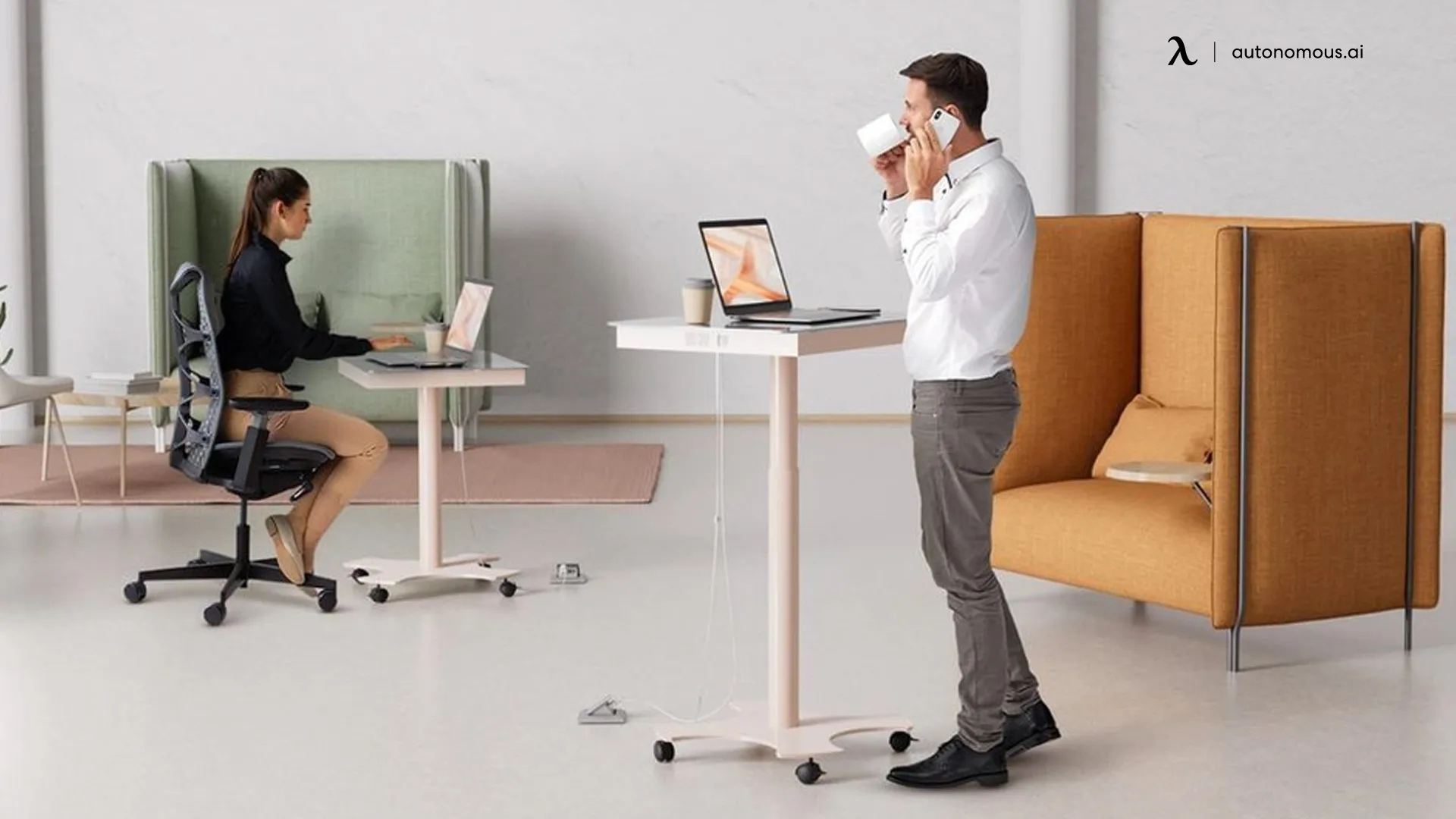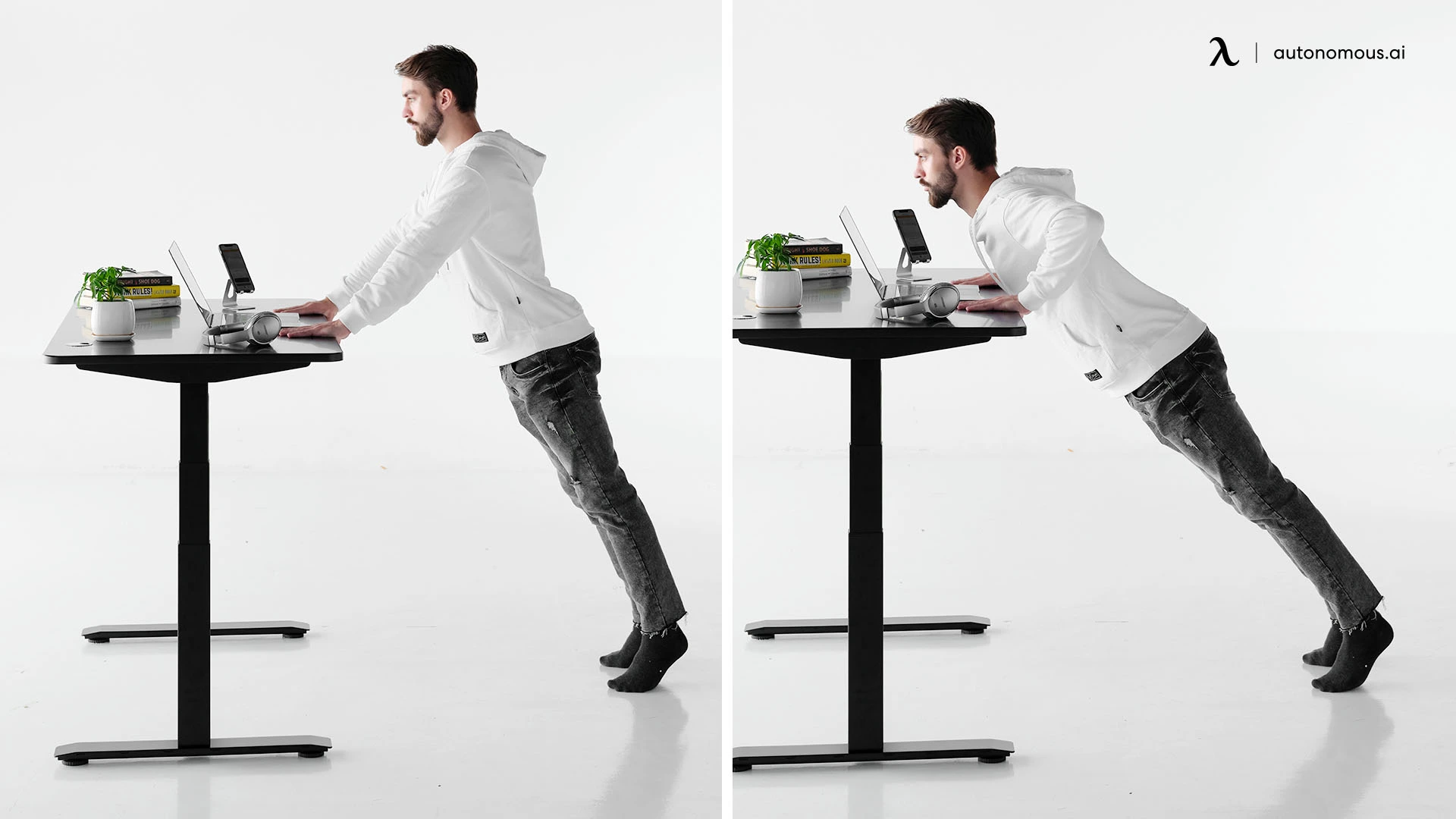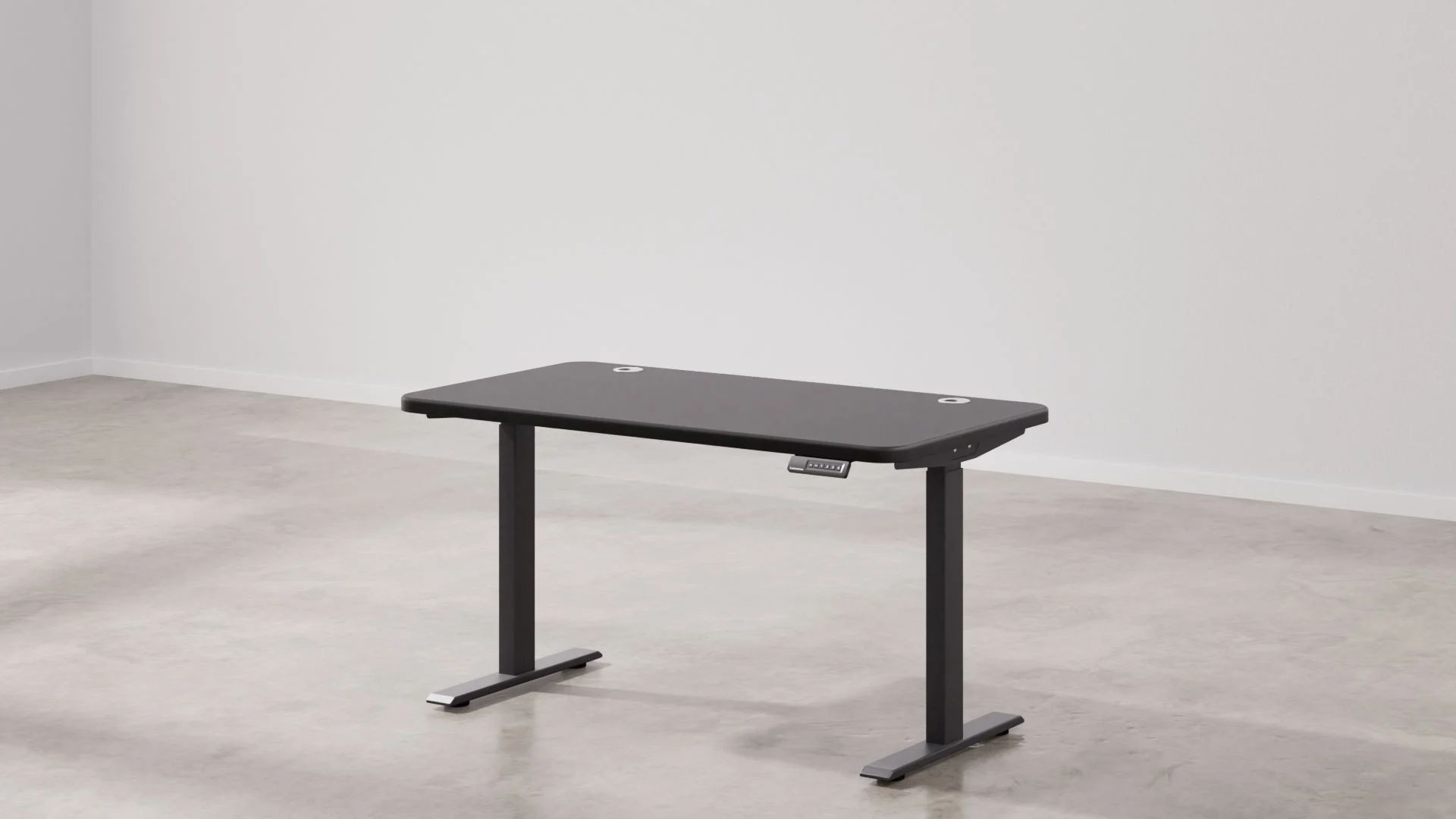.webp)
Table of Contents
In today’s world, where working from home is common and sitting for hours is the norm, many people are searching for ways to stay active throughout the day.
One surprising but simple solution? A standing desk. Using a standing desk for weight loss has become a popular idea, especially among remote workers trying to stay healthy during long workdays. But does a standing desk help lose weight, or is it just a trend?
Let’s walk through how standing desks can support your weight loss journey—and how to use them effectively for better health.
Why Sedentary Habits Are A Concern
Many remote workers have fallen into a sedentary routine without realizing it. Long hours of sitting, limited movement, and lack of structure can all quietly lead to weight gain. Research, including a study from the University of Warwick, links prolonged sitting to a greater risk of obesity, heart disease, and even respiratory problems.
Sitting for long periods slows your metabolism, affects your posture, and may lead to weight gain. A standing desk helps lose weight by encouraging more natural movement throughout your day.
The bottom line? Small changes in your daily movement patterns can make a big difference, especially over time.
Does A Standing Desk Help Lose Weight?
So, will a standing desk help me lose weight on its own? Yes, they do—although not dramatically on their own. The truth is, just standing burns a few extra calories, but the real benefit comes when you pair it with standing desk exercises to lose weight—simple activities you can do without leaving your workstation.
Standing burns more calories than sitting. According to research from the American Heart Association, standing for around six hours a day can help you burn about 54 extra calories. That’s not huge, but over time, it adds up—especially when combined with light movement.
More importantly, standing makes it easier to move. When you’re already upright, you’re more likely to stretch, walk around, or do quick exercises between tasks. That’s where the real weight-loss potential lies.
To lose weight by standing desk usage, you have to incorporate a physical regimen. There are more calories burned by standing desk exercises since you are considerably more active. A standing desk provides enough room to perform these exercises.

How To Use A Standing Desk For Weight Loss
When used the right way, a standing desk for weight loss becomes much more than a height-adjustable table—it turns into a platform for daily movement. This section shows you how to make the most of your setup so your standing desk helps lose weight through habit and consistency.
Here’s a detailed, step-by-step approach:
1. Start Gradually With Sit-Stand Cycles
Begin by alternating between sitting and standing every 30 to 60 minutes. Your body burns slightly more calories when standing than sitting, but more importantly, these sit-stand transitions activate your muscles and circulation. This prevents the energy slump that often comes from sitting for too long. If you’re new to standing desks, aim for 1–2 total hours of standing per day and slowly increase it over time.
Use a timer, phone alert, or smart app to remind you when it’s time to switch. These gentle cues help build a sustainable rhythm that becomes second nature.
Starting gradually also reduces the risk of joint or foot discomfort, which keeps your routine consistent and sustainable in the long run. As your endurance builds, you naturally burn more calories, which supports your goal of using a standing desk for weight loss.
2. Set Up The Right Posture
Standing posture matters just as much as how long you stand. Proper alignment makes your muscles work more efficiently, helping your standing desk efforts to lose weight efforts become more effective over time.
- Elbows: Keep them bent at a 90-degree angle, close to your body.
- Screen height: Your monitor should be at eye level to avoid neck strain. Use this breakdown of how high should a standing desk be to find the right height that fits your posture and screen level
- Feet: Stand with both feet flat, shoulder-width apart, with knees slightly bent—not locked.
- Shoulders: Keep them relaxed, not hunched forward.
Poor posture leads to tension, fatigue, and even pain, which can discourage you from standing or moving altogether. But when your posture is aligned, your muscles are properly engaged, especially your core, glutes, and back.
You’ll also want to fine-tune your positioning—this guide to standing desk ergonomics walks through how to align your arms, wrists, and eyes comfortably.

3. Incorporate Micro-Movements
Standing at a standing desk for weight loss doesn’t have to be static. Small, natural movements throughout the day—like swaying from side to side, rolling your shoulders, shifting your weight between legs, or doing ankle circles—can keep your body active even during deep focus work. These small shifts may not feel like exercise, but when done throughout the day, they add up, especially when paired with standing desk exercises to lose weight.
- Shifting your weight from side to side
- Bouncing gently on your toes
- Rolling your shoulders
- Marching in place for a few seconds
- Wiggling your hips or rotating your ankles
Over hours and days, these subtle calorie burns accumulate. They also reduce stiffness and improve flexibility, so you’re more likely to feel comfortable and stay on your feet longer, amplifying your total daily energy expenditure.
4. Use Short Breaks For Desk-Friendly Exercises
Short, intentional breaks for movement—just 3 to 5 minutes—can make a big difference in your daily activity level. These bursts of movement act like mini workouts. By intentionally scheduling standing desk exercises to lose weight, you boost calorie burn and fight afternoon sluggishness.
Here are examples of easy moves you can do without leaving your workspace:
- Bodyweight squats: Stand behind your chair, lower yourself as if sitting in an invisible chair, then rise back up.
- Standing lunges: Step one foot forward and bend both knees, then return and switch legs.
- Desk push-ups: Place your hands on your desk, step back slightly, and do modified push-ups.
- Neck and shoulder rolls: Gently loosen any tension built up during work.
These muscles require more energy to work, meaning they burn more calories compared to smaller muscles. Even a few reps here and there throughout the day can add up to a significant calorie burn.
Plus, these mini-workouts give your metabolism a nudge, improve circulation, and fight the sluggish feeling that often leads to snacking or afternoon fatigue. Therefore, you can feel the slow but steady improvements with your standing desk for weight loss.
5. Be Consistent, Not Perfect
You don’t need to turn your day into a workout routine. The most important thing is to move a regular part of your workday. Even standing an hour longer per day adds up to over 250 extra hours per year, which helps improve a lot on your journey with a standing desk for weight loss.
Consistency creates real change, even if it’s in small, manageable doses.
If you’re just getting started, this guide on how to use a standing desk can help you ease into a healthy sit-stand rhythm.

Desk-Friendly Exercises To Boost Your Progress
You don’t need to be a fitness pro to benefit from standing desk exercises to lose weight. Moves like squats, lunges, and calf raises keep your major muscle groups engaged and your metabolism active. These desk-friendly exercises are designed to be easy, low-impact, and practical, even in tight home office spaces.
They gently elevate your heart rate, engage large muscle groups, and help reduce stiffness from long hours of work.
Here are some simple standing desk exercises you can try:
1. Desk Squats
Stand a few inches behind your chair or desk with your feet shoulder-width apart. Slowly lower your body by bending your knees, keeping your back straight—as if you’re about to sit in a chair. Stop when your thighs are almost parallel to the ground, then press through your heels to return to standing.
Why it helps: Engages your glutes, quads, and core, helping to build lower-body strength and burn calories.
2. Standing Lunges
Take a step forward with one leg, bending both knees so your back knee hovers just above the ground. Push through your front foot to return to the starting position, then switch sides. Use your desk for balance if needed.
Why it helps: Strengthens legs and hips while improving balance and circulation after sitting.
3. Calf Raises
Stand tall with feet hip-width apart. Slowly rise onto the balls of your feet, hold for a moment, and then gently lower back down. Repeat for 10–15 reps.
Why it helps: Activates the calf muscles and improves ankle mobility—perfect for reactivating your lower legs after standing or sitting.
4. Desk Push-Ups
Place your hands shoulder-width apart on the edge of your desk. Step back until your body is at a diagonal, then bend your elbows to lower your chest toward the desk. Push back up slowly.
Why it helps: Works your chest, shoulders, and arms while keeping impact low.
5. Neck, Shoulder, And Wrist Rolls
Roll your shoulders backward and forward in slow circles. Gently rotate your neck side to side, and flex and extend your wrists.
Why it helps: Relieves tension from working on a computer and supports joint health, especially for desk-bound workers.
My Tip: Try doing 2–3 of these movements between meetings or during short breaks. Even 5 minutes of intentional movement can refresh your mind and keep your metabolism active.
Repeat these throughout your workday to turn your standing desk for weight loss into a practical tool for energy and long-term wellness.

Choosing The Right Standing Desk For Weight Loss
If your goal is to stay more active and lose weight while working, the type of standing desk you use plays a big role. The right desk setup will support movement, comfort, and ease of use, so you can build healthy habits without added stress or distractions.
Here’s what to consider:
1. Height Adjustability
If you’re using a standing desk for weight loss, your setup needs to support frequent transitions and steady movement. A quality standing desk should adjust to different heights quickly and smoothly. Whether you’re tall or petite, the desk should let you maintain a 90-degree angle at your elbows and keep your monitor at eye level.
You can search for electric desks with digital controls or memory presets. These allow you to shift from sitting to standing with a single button—no cranking or manual lifting.
2. Stability During Movement
If you plan to do squats or light stretches at your desk, it must stay firmly in place. A desk that wobbles when you lean or type can throw off your form and be distracting.
A standing desk with steel frames, dual-motor systems, and wide leg bases is the perfect choice that you should opt for. These features keep the desk solid and stable, even during movement.
A good standing desk base gives you the flexibility and strength you need for frequent position changes and light desk workouts.

3. Easy Transitions Between Positions
To build a habit of alternating between sitting and standing, the desk needs to make that switch effortless.
Desks with whisper-quiet motors and programmable height settings will help you have the smoothest transitions. The less friction involved, the more likely you’ll use the standing feature consistently.
4. Ample Space For Movement
You’ll want enough room under and around your desk to move freely. Crowded spaces can make standing and stretching feel cramped or awkward.
A clean layout, with cable management features and no bulky storage under the desk that gets in the way of your legs or feet.
5. Supportive Accessories
The right office accessories can make long hours at a standing desk more comfortable and sustainable.
- Anti-fatigue mats help cushion your feet and reduce joint pressure.
- Monitor arms keep screens at the correct height and free up desk space.
- Footrests or balance boards encourage subtle movement and improve circulation.
The more comfortable and stable your workstation is, the easier it becomes to stick with standing desk exercises to lose weight and keep moving consistently.
6. Adaptability For Long-Term Use
A standing desk should grow with you. Whether your needs change or you redesign your space, having a flexible, modular desk ensures you can stay active without giving up function or comfort.
Desks with adjustable width or add-ons like treadmill compatibility, cable trays, or desk drawers will stay with you for nearly a lifetime.

Recommended Products To Support Your Goals
If you’re looking for a desk that makes it easy to stay active and incorporate standing desk exercises to lose weight, here are three reliable options:
- Autonomous Desk 2 – A strong, affordable sit-stand desk with programmable height presets and smooth adjustment. Great for beginners starting their standing desk for weight loss routine.
- Autonomous Desk 5 – Offers an advanced design with improved stability, near-silent dual motors, and a sleek aesthetic. Ideal for those who switch positions frequently and want a smarter, more responsive setup.
- Autonomous Desk 2 L-Shaped – With its generous surface area, this L-shaped model gives you space to stretch, squat, and work without constraint. Perfect for multitaskers or anyone creating a high-mobility office layout.
Each of these desks supports your efforts to stay moving, stay focused, and get the most from your standing desk for your weight loss journey.
FAQs
1. Does having a standing desk help you lose weight?
Yes—A standing desk helps lose weight by encouraging frequent movement and better posture, especially when paired with standing desk exercises to lose weight.
These small but consistent movements can help you burn more calories and prevent weight gain over time. You can explore true benefits on our article about the standing desk benefits.
2. How long should I stand at my desk each day?
Begin with standing for about 1–2 hours total per day, then gradually increase it. Aim to break up sitting with standing in short intervals rather than trying to stand for long blocks at a time.
However, if you want to understand better and figure out the ideal frequency for your working routine, you can check out our guide on how long you should you stand at a standing desk.
3. What’s the best exercise to do at a standing desk?
Bodyweight squats, calf raises, and desk push-ups are all easy, effective exercises that fit into short breaks. They activate large muscle groups and can be done in small spaces without any equipment.
4. Do I need special gear to use a standing desk for exercise?
Not necessarily. While an anti-fatigue mat and comfortable shoes can help, the most important part is building movement into your day. Even simple stretches or balance shifts can support your goals.
5. Is it healthy to stand all day at a standing desk?
Standing all day isn’t ideal either. Just like too much sitting, too much standing can lead to fatigue, joint strain, or lower back pain. The healthiest option is to alternate between sitting and standing every 30 to 60 minutes and to move regularly throughout the day.
6. How can I maximize my results with a standing desk?
Alternate between sitting and standing, maintain good posture, and do light standing desk exercises to lose weight, like squats or calf raises. These small changes help your standing desk help you lose weight efforts feel natural and effective.
Final Thoughts
Using a standing desk is about creating more opportunities to move. It helps you shift out of sedentary habits, feel more energized, and—yes—support your weight loss goals in a natural, sustainable way.
The more you stand, stretch, and move throughout your day, the more your body (and mind) will thank you. It’s not about doing everything at once—it’s about making small, healthy choices that add up over time.
If you’re working remotely, thinking about how your workspace supports your habits is key. This layout guide for a standing desk home office setup offers ideas to move a natural part of your day.
Spread the word
.svg)



.webp)



(1).webp)



